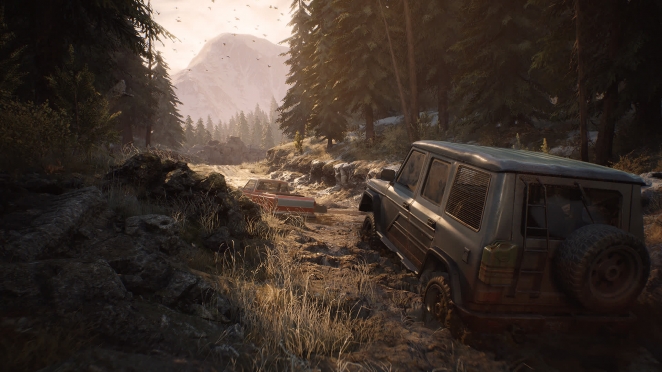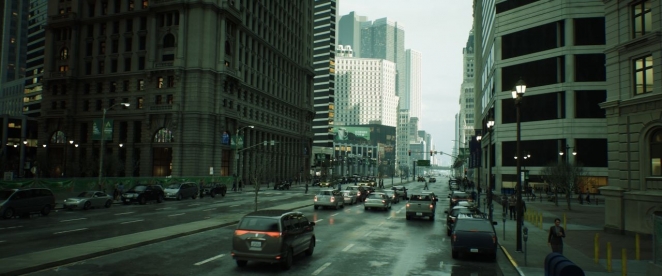There seems to be a lot of buzz around Unreal Eengine 5 (UE5) at the moment, so we decided to check it out.
What is Unreal Engine?
Unreal Engine is (primarily) a game engine, and has been one of the key players in the game dev world for years. It allows developers to create games and render them in real-time.
As it developed over the years, it began to seep into other industries; most notably the architectural visualization and film industry. This is primarily due to the quick feedback that real-time rendering provides.
So, what’s with the sudden hype?

Unreal Engine 5 has introduced some new groundbreaking features; most notably Nanite and Lumen. There are other new features, but I would consider Nanite and Lumen to be the main ones for motion graphic designers.
Nanite is essentially a dynamic LoD (level-of-detail) system, which allows for lots of very high-poly geometry to be rendered in real-time. This not only allows for complex scenes to be created, but also rendered in real-time. It also allows for assets to be created and imported without relying on displacement maps or LoD models.
Lumen is essentially a dynamic Global Illumination system. This probably doesn’t sound very groundbreaking to those outside of the game-dev world. Most (if not all) offline renderers use dynamic GI. If you animate something moving, you would expect the GI to react to the movement, right? The reason this is of significance is that it’s bridging the gap between real-time rendering and offline rendering.
UE5 also has the Quixel Megascans library built into it, which is free to use (in this context – you have to pay if you plan to use the Quixel Megascans assets outside of UE5). The library contains a plethora of incredibly-detailed assets for you to use, allowing you to build high-quality scenery and decorate interiors efficiently.
Take the features listed above, and add in the ability to not only create motion graphic pieces, but to make them interactive… and you have something that may well threaten offline rendering.
Is this the new go-to for rendering motion graphics?

In my opinion, not quite – at least not yet. It has a lot of similarities and features that offline rendering offers, but I wouldn’t consider it to be in a state to completely replace offline rendering. I’ve listed a few issues that stuck out to me whilst trying out UE5.
Transparency
For me, it all begins to fall apart as soon as glass is introduced. Lumen doesn’t like ‘translucency’ (i.e. glass-like materials), and the way refraction looks is a bit underwhelming.
There are ways to force translucency to be calculated by raytracing, although it doesn’t seem to be ideal for animation. Raytracing requires a lot of samples to yield clean results (which means long render times), although the amount of samples used can be reduced and compensated with the built-in denoiser – although this often results in wobbly, blotchy patches in renders (that ol’ classic).
It also means that you’re unlikely to be seeing the results you were hoping for when rendering in real-time.
Quality issues in the first few frames of animation
Another niche technical issue to mention is to do with ‘warm-up’ frames. These are used to give the engine a chance to calculate the scene in real-time before setting off any renders; otherwise, you’ll end up with some undesirable results on the first few frames of your renders.

Efficiency
Real-time rendering saves time on visual feedback, but time is still required for compiling shaders and importing assets. Depending on the complexity* of the assets and shaders (or scenes) that need importing, you could be twiddling your thumbs for quite a while.
*I don’t have enough experience with game engines to know what factors come into play here, but I know that loading detailed prefab scenes can take a long while,
Importing from external 3D software
If your animations are created outside of UE5, consider how often those animations may need amending or refining, as this may impact your workflow. I also recommend creating shaders within UE5, rather than importing them from 3rd-party software; in my case, I was importing materials from C4D which were converted to UE5 shaders, but the conversion didn’t work quite how I expected it to.
Another thing to note for C4D users: any hidden objects won’t be imported. This can be an issue if you depend on animated visibility, or use hidden objects to drive other objects; the latter scenario may simply be a case of baking animations and deleting the hidden objects prior to importing into UE5, but I can’t think of a solution for the former scenario. UE5 does seem to handle mograph surprisingly well though.
Learning curve
Lastly, the jump from traditional 3D software to UE5 isn’t too straightforward. You will likely have a better chance of understanding how things work if you have some experience with 3D, but there’s still a lot to learn. If you plan to use UE5 for the first time, I advise spending a bit of time getting familiar with it before diving straight-in with a project in mind.
When should I consider using Unreal Engine 5?

UE5 is worth considering if you plan on creating a VR piece, interactive installation, or something else that maximizes the use of real-time rendering. Unless you need the results to be rendered in real-time (for quick visual feedback, etc), I wouldn’t use it to replace an offline renderer.
An exception to this would be if you were to create something stylised. In which case it may be worth doing some RnD to check it can yield the results you’re after. The Quixel Megascans library is also a big factor to consider, depending on the type of project you plan to work on and the resources that you have available to you. Although, a separate subscription for this can be purchased if desired.
Conclusion
UE5 looks very promising, and looks to be bridging the gap between offline rendering and real-time rendering. But I don’t think it’s in a position to completely replace offline rendering. It does, however, open up more possibilities for motion graphic designers, by giving them the ability to make their designs interactive, whilst still allowing for some high quality renders. And best of all, it’s free*!
*unless you’re earning megabucks from the renders, although this may just apply to games… always check the terms and conditions to be safe.







